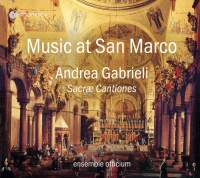Texte paru dans: / Appeared in: |
|
|
Outil de traduction ~ (Très approximatif) |
|
|
Reviewer: Barry
Brenesal Andrea Gabrieli shows up on the quartermaster’s list serving Albrecht V, Duke of Bavaria, in 1562. That same list also features Orlandus Lassus, who became a lifelong friend of the composer. After Gabrieli returned to Venice, he composed and in 1565 published his Sacrœ Cantiones, which were dedicated to Albrecht. Rombach’s liner notes suggest this may have been an attempt to secure for himself a position in the court chapel; Lassus had by that time secured the post of maestro di cappella. If so, and there’s evidence of this, the plan didn’t succeed, though the work probably helped Gabrieli secure the post of organist at prestigious San Marco the following year. He retained it for the rest of his life. Ironically, Albrecht’s son and successor, Wilhelm V, tried to entice the composer back to the Bavarian court in 1574, but failed thanks to a combination at San Marco of prestige, good pay, fine musicians at his disposal, and like-minded colleagues: Claudio Merulo was his deputy, and Gioseffo Zarlino the San Marco’s music director. All this made Gabrieli’s job as much a matter of pleasure as work. The Sacrœ Cantiones consists of 24 motets, of which 12 are presented on this release. Rombach quotes with approval a comment on its title page that it may be performed with “fresh voices and with instruments of every kind.” He states this provides us “with a clear concept of the customary practice of the era,” and it just might. Though as the publisher, Antonio Gardano, placed these same or very similar words on other, comparable works of the time, it’s also possible he just meant it to help sell the music to a broader performing audience. In any case, it’s long been established that during this period, much European sacred music intended for vocal forces was often by larger or smaller ensembles, and that instrumental arrangements were common as well. Polychoral compositions with instruments were also an important feature of one of Zarlino’s predecessors, Adrian Willaert. What we have here, then, are a variety of differing textures applied to each of the works—and in the case of two compositions, multiple performances. O sacrum convivium is heard as played by brass choir—cornett and trombones—and by 11 of the 21 singers Rombach has assembled here as his latest version of the ensemble officium. (Given the increase in its sheer size over some of their earlier releases, in particular the final Domine Dominus noster that makes so fine a use of the entire ensemble, shouldn’t Rombach have at least adopted upper case first letters for the group’s name, just this once?) Laudate Dominum omnes gentes in turn is heard first with brass ensemble, and later with cornett and organ, with cornettist Friederike Otto improvising divisions according to principles that were laid down in writing at the time. Between these two pieces is Laudate Dominum in sanctis eius, the only included work that doesn’t derive from the Sacrœ Cantiones. Published in 1587 in a collection featuring both Andrea and his nephew Giovanni, it could almost be called in modern terms a parody motet, the opening theme and the descending figure of the earlier work both being clearly present. The performances are all one could hope for. Each voice part is distinct yet balanced ideally against the others, with an attention to discretely expressive phrasing and clarity of enunciation. The Ensemble Gabinetto Armonico is fully the equal of its compatriots, and the various groupings of musicians for each ensemble, separately and together, make for an attractive experience. The engineering is just right, neither airless nor drowning the performers in over-reverberance. Highly recommended. Is there any chance we could have Rombach turn his attention to the rest of the music in this delightful collection? | |
|
Support us financially by purchasing this disc from eiher one of these
suppliers.
|
|
|
|
|
|
Cliquez l'un ou l'autre
bouton pour découvrir bien d'autres critiques de CD |
|




